JVC MX-G750V, MX-G850V, MX-G880V, MX-G950V Service Manual
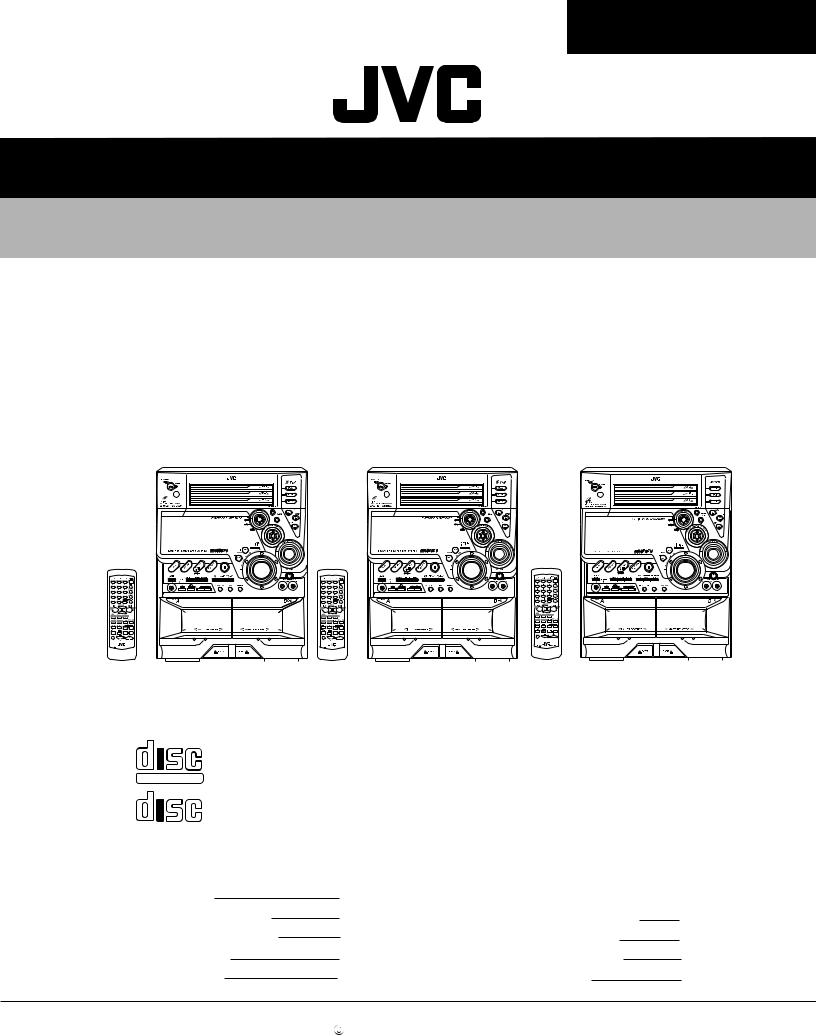
MX-G950V/MX
MX-G950V/MX-G880V880V
MX-G850V/MX-G750V
MX-G850V/MX-G750V
SERVICE MANUAL
COMPACT COMPONENT SYSTEM
MX-G950V/MX-G880V
MX-G850V/MX-G750V
|
|
|
|
|
|
|
|
|
|
|
|
|
|
|
|
|
|
|
|
|
|
|
|
|
|
|
|
|
|
|
|
|
|
|
|
|
|
|
|
|
|
|
|
|
|
|
|
|
|
|
|
|
|
|
|
|
|
|
|
|
|
|
|
|
|
|
|
|
|
|
|
|
|
|
|
|
|
|
|
|
|
|
|
|
|
|
|
|
|
|
|
|
|
|
|
|
|
|
|
|
|
|
|
|
|
|
|
|
|
|
|
|
|
|
|
|
|
|
|
|
|
|
|
|
|
|
|
|
|
|
|
|
|
|
|
|
|
|
|
|
|
|
|
|
|
|
|
|
|
|
|
|
|
|
|
|
|
|
|
|
|
|
|
|
|
|
|
|
|
|
|
|
|
|
|
|
|
|
|
|
|
|
|
|
|
|
|
|
|
|
|
|
|
|
|
|
|
|
|
|
|
|
|
|
|
|
|
|
|
|
|
|
|
|
|
|
|
|
|
|
|
|
|
|
|
|
|
|
|
|
|
|
|
|
|
|
|
|
|
|
|
|
|
|
|
|
|
|
|
|
|
|
|
|
|
|
|
|
|
|
|
|
|
|
|
|
|
|
|
|
|
|
|
|
|
|
|
|
|
|
|
|
|
|
|
|
|
|
|
|
|
|
|
|
|
|
|
|
|
|
|
|
|
|
|
|
|
|
|
|
|
|
|
|
|
|
|
|
|
|
|
|
|
|
|
|
|
|
|
|
|
|
|
|
|
|
|
|
|
|
|
|
|
|
|
|
|
|
|
|
|
|
|
|
|
|
|
|
|
|
|
|
|
|
|
|
|
|
|
|
|
|
|
|
CA-MXG950V |
|
|
|
|
|
|
|
|
|
|
CA-MXG850V |
|
|
|
|
|
|
|
CA-MXG750V |
|||||||||||||||||||
|
|
|
|
|
|
|
|
|
|
|
|
|
|
|
|
|
|
|
|
|
|
|
|
CA-MXG880V |
|
|
|
|
|
|
|
|
|
|
|
|
|
||||||||
|
|
COMPACT |
|
|
|
|
|
|
|
|
|
|
|
|
|
|
|
|
|
|
|
|
|
|
|
|
|
|
|
|
|
|
|
|
|
|
|
|
|||||||
|
MX-G950V/MX-G850V |
|
|
|
MX-G880V |
|
|
|
|
|
|
|
|
MX-G750V |
|||||||||||||||||||||||||||||||
|
|
|
|
|
|
|
|
|
|
|
|
|
|
|
|
|
|
|
|
|
|||||||||||||||||||||||||
|
|
|
|
|
|
|
|
|
|
|
|
|
|
Area Suffix |
|
|
|
|
Area Suffix |
|
|
|
|
|
|
|
|
Area Suffix |
|||||||||||||||||
|
|
DIGITAL VIDEO |
|
|
|
|
|
|
|
|
|
|
|
|
|
|
|
|
|||||||||||||||||||||||||||
|
|
U |
|
|
|
Other Areas |
|
|
|
|
|
|
|
|
|
|
UN |
|
|
|
Asean |
||||||||||||||||||||||||
|
|
COMPACT |
|
|
|
|
|
|
|
|
|
|
|
|
|
|
|
|
|
|
|
|
|
||||||||||||||||||||||
|
|
UN |
|
|
|
|
|
|
Asean |
|
|
UN |
Asean |
|
|
US |
|
|
|
Singapore |
|||||||||||||||||||||||||
|
|
|
|
|
|
|
|
|
|
|
|
|
|
|
|
|
|
|
|
|
|
|
|||||||||||||||||||||||
|
|
|
|
|
|
|
|
|
|
UX--------------- |
|
|
|
Saudi Arabia |
|
|
|
|
|
|
|
|
|
|
|
|
|
|
|
UX--------------- |
|
Saudi Arabia |
|||||||||||||
|
|
DIGITAL AUDIO |
|
|
|
|
|
|
|
|
|
|
|
|
|
|
|
|
|
|
|
|
|
|
|
|
|
|
|
|
|
|
|
|
|
|
|
|
|||||||
|
|
|
|
|
|
|
|
|
|
|
|
|
|
|
|
|
|
|
|
|
|
|
|
|
|
|
|
|
|
|
|
|
|
|
|
|
|||||||||
Contents
Safety precautions |
1-2 |
Preventing static electricity |
1-3 |
Important for laser products |
1-4 |
Disassembly method |
1-5 |
Adjustment method |
1-28 |
Flow of functional operation |
|
until TOC read (CD) |
1-33 |
Maintenance of laser pickup |
1-34 |
Replacement of laser pickup |
1-34 |
Description of major ICs |
1-35~56 |
No.21099
COPYRIGHT 2002 VICTOR COMPANY OF JAPAN, LTD. |
1-1 |
|
Jul. 2002 |
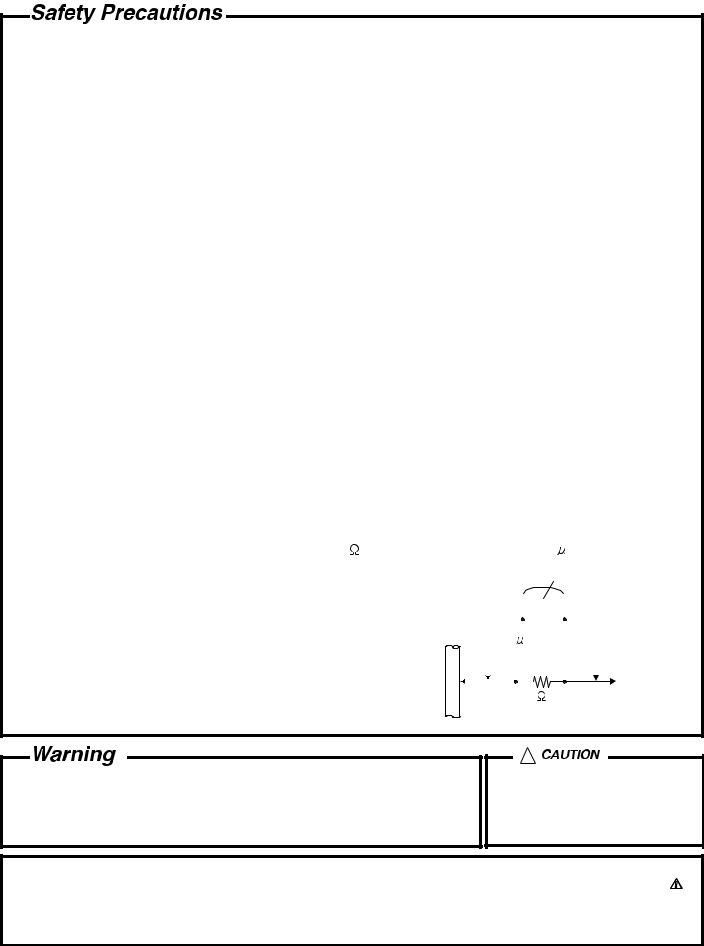
MX-G950V/MX-G880V
MX-G850V/MX-G750V
1.This design of this product contains special hardware and many circuits and components specially for safety purposes. For continued protection, no changes should be made to the original design unless authorized in writing by the manufacturer. Replacement parts must be identical to those used in the original circuits. Services should be performed by qualified personnel only.
2.Alterations of the design or circuitry of the product should not be made. Any design alterations of the product should not be made. Any design alterations or additions will void the manufacturer`s warranty and will further relieve the manufacture of responsibility for personal injury or property damage resulting therefrom.
3.Many electrical and mechanical parts in the products have special safety-related characteristics. These characteristics are often not evident from visual inspection nor can the protection afforded by them necessarily be obtained by using replacement components rated for higher voltage, wattage, etc. Replacement parts which
have these special safety characteristics are identified in the Parts List of Service Manual. Electrical components having such features are identified by shading on the schematics and by ( ) on the Parts List in the Service Manual. The use of a substitute replacement which does not have the same safety characteristics as the recommended replacement parts shown in the Parts List of Service Manual may create shock, fire, or other hazards.
) on the Parts List in the Service Manual. The use of a substitute replacement which does not have the same safety characteristics as the recommended replacement parts shown in the Parts List of Service Manual may create shock, fire, or other hazards.
4.The leads in the products are routed and dressed with ties, clamps, tubings, barriers and the like to be separated from live parts, high temperature parts, moving parts and/or sharp edges for the prevention of electric shock and fire hazard. When service is required, the original lead routing and dress should be observed, and it should be confirmed that they have been returned to normal, after re-assembling.
5.Leakage currnet check (Electrical shock hazard testing)
After re-assembling the product, always perform an isolation check on the exposed metal parts of the product (antenna terminals, knobs, metal cabinet, screw heads, headphone jack, control shafts, etc.) to be sure the product is safe to operate without danger of electrical shock.
Do not use a line isolation transformer during this check.
 Plug the AC line cord directly into the AC outlet. Using a "Leakage Current Tester", measure the leakage current from each exposed metal parts of the cabinet, particularly any exposed metal part having a return path to the chassis, to a known good earth ground. Any leakage current must not exceed 0.5mA AC (r.m.s.).
Plug the AC line cord directly into the AC outlet. Using a "Leakage Current Tester", measure the leakage current from each exposed metal parts of the cabinet, particularly any exposed metal part having a return path to the chassis, to a known good earth ground. Any leakage current must not exceed 0.5mA AC (r.m.s.).
 Alternate check method
Alternate check method
Plug the AC line cord directly into the AC outlet. Use an AC voltmeter having, 1,000 ohms per volt or more
sensitivity in the following manner. Connect a 1,500 |
10W resistor paralleled by a 0.15 F AC-type capacitor |
||||||||||||
between an exposed metal part and a known good earth ground. |
|
|
|
|
|
|
|
|
|
AC VOLTMETER |
|||
Measure the AC voltage across the resistor with |
the AC |
|
|
|
|
|
|
|
|
|
(Having 1000 |
||
voltmeter. |
|
|
|
|
|
|
|
|
|
|
|
ohms/volts, |
|
|
|
|
|
|
|
|
|
|
|
|
|||
Move the resistor connection to each exposed metal part, |
|
|
|
|
|
|
|
|
|
or more sensitivity) |
|||
|
|
|
|
|
|
|
|
|
|
|
|||
particularly any exposed metal part having a return |
path to |
|
|
|
|
|
|
|
|
|
|
|
|
0.15 F AC TYPE |
|
||||||||||||
the chassis, and meausre the AC voltage across the resistor. |
|
||||||||||||
|
|
|
|
|
|
|
|
|
|
|
|||
Now, reverse the plug in the AC outlet and repeat each |
|
|
|
|
|
|
|
|
|
|
Place this |
||
|
|
|
|
|
|
|
|
|
|
||||
|
|
|
|
|
|
|
|
|
|
||||
measurement. Voltage measured any must not exceed 0.75 V |
|
|
|
|
|
|
|
|
|
|
|
probe on |
|
|
|
|
|
|
|
|
|
|
|
|
|||
|
|
|
|
|
|
|
|
|
|
|
each exposed |
||
AC (r.m.s.). This corresponds to 0.5 mA AC (r.m.s.). |
|
|
1500 |
|
10W |
|
|||||||
|
|
|
|
metal part. |
|||||||||
Good earth ground
1.This equipment has been designed and manufactured to meet international safety standards.
2.It is the legal responsibility of the repairer to ensure that these safety standards are maintained.
3.Repairs must be made in accordance with the relevant safety standards.
4.It is essential that safety critical components are replaced by approved parts.
5.If mains voltage selector is provided, check setting for local voltage.
!
Burrs formed during molding may be left over on some parts of the chassis. Therefore, pay attention to such burrs in the case of preforming repair of this system.
In regard with component parts appearing on the silk-screen printed side (parts side) of the PWB diagrams, the parts that are printed over with black such as the resistor ( ), diode (
), diode (  ) and ICP (
) and ICP ( ) or identified by the " " mark nearby are critical for safety.
) or identified by the " " mark nearby are critical for safety.
(This regulation does not correspond to J and C version.)
1-2
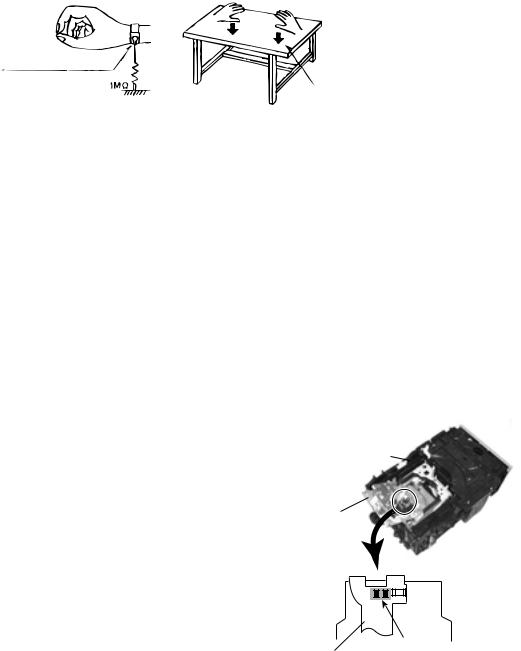
MX-G950V/MX-G880V
MX-G850V/MX-G750V
Preventing static electricity
1. Grounding to prevent damage by static electricity
Electrostatic discharge (ESD), which occurs when static electricity stored in the body, fabric, etc. is discharged, can destroy the laser diode in the traverse unit (optical pickup). Take care to prevent this when performing repairs.
2. About the earth processing for the destruction prevention by static electricity
In the equipment which uses optical pick-up (laser diode), optical pick-up is destroyed by the static electricity of the work environment.
Be careful to use proper grounding in the area where repairs are being performed.
2-1 Ground the workbench
Ground the workbench by laying conductive material (such as a conductive sheet) or an iron plate over it before placing the traverse unit (optical pickup) on it.
2-2 Ground yourself
Use an anti-static wrist strap to release any static electricity built up in your body.
(caption)
Anti-static wrist strap
Conductive material (conductive sheet) or iron plate
3. Handling the optical pickup
1. In order to maintain quality during transport and before installation, both sides of the laser diode on the replacement optical pickup are shorted. After replacement, return the shorted parts to their original condition. (Refer to the text.)
2.Do not use a tester to check the condition of the laser diode in the optical pickup. The tester's internal power source can easily destroy the laser diode.
4. Handling the traverse unit (optical pickup)
1.Do not subject the traverse unit (optical pickup) to strong shocks, as it is a sensitive, complex unit.
2.Cut off the shorted part of the flexible cable using nippers, etc. after replacing the optical pickup. For specific details, refer to the replacement procedure in the text. Remove the anti-static pin when replacing the traverse unit. Be careful not to take too long a time when attaching it to the connector.
3.Handle the flexible cable carefully as it may break when subjected to strong force.
4.It is not possible to adjust the semi-fixed resistor that adjusts the laser power. Do not turn it
Attention when traverse unit is decomposed
*Please refer to "Disassembly method" in the text for pick-up and how to detach the CD traverse mechanism.
CD changer mechanism assembly
1.Remove the disk stopper and T. bracket on the CD changer mechanism assembly.
2.Disconnect the harness from connector on the CD motor board.
3.CD traverse unit is put up as shown in Fig.1.
4.Solder is put up before the card wire is removed from connector CN601 on the CD servo control board as shown in Fig. 2.
(When the wire is removed without putting up solder, the CD pick-up assembly might destroy.)
5.Please remove solder after connecting the card wire with CN601 when you install picking up in the substrate.
CD traverse unit
Fig.1
Soldering
Flexible cable |
Fig.2 |
|
1-3

MX-G950V/MX-G880V
MX-G850V/MX-G750V
Important for laser products
1.CLASS 1 LASER PRODUCT
2.DANGER : Invisible laser radiation when open and inter lock failed or defeated. Avoid direct exposure to beam.
3.CAUTION : There are no serviceable parts inside the Laser Unit. Do not disassemble the Laser Unit. Replace the complete Laser Unit if it malfunctions.
4.CAUTION : The compact disc player uses invisible laser radiation and is equipped with safety switches which prevent emission of radiation when the drawer is open and the safety interlocks have failed or are defeated. It is dangerous to defeat the safety switches.
5.CAUTION : If safety switches malfunction, the laser is able
to function.
6.CAUTION : Use of controls, adjustments or performance of procedures other than those specified herein may result in hazardous radiation exposure.
! CAUTION Please use enough caution not to see the beam directly or touch it
in case of an adjustment or operation check.
VARNING : Osynlig laserstrålning är denna del är öppnad och spårren är urkopplad. Betrakta ej strålen.
VARO : Avattaessa ja suojalukitus ohitettaessa olet alttiina näkymättömälle lasersäteilylle.Älä katso säteeseen.
ADVARSEL : Usynlig laserstråling ved åbning , når sikkerhedsafbrydere er ude af funktion. Undgå udsættelse for stråling.
ADVARSEL : Usynlig laserstråling ved åpning,når sikkerhetsbryteren er avslott. unngå utsettelse for stråling.
REPRODUCTION AND POSITION OF LABELS
WARNING LABEL
CLASS 1
LASER PRODUCT
1-4
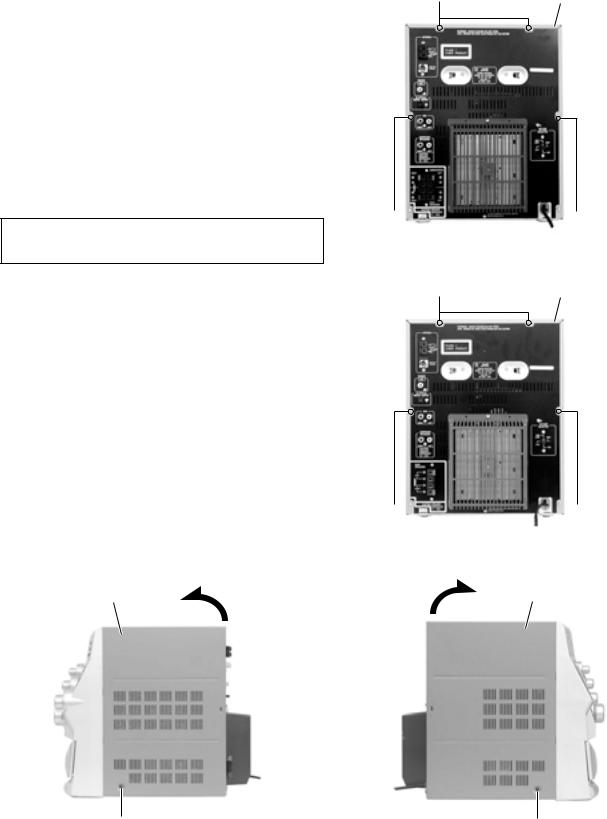
Disassembly method
<Main body>
 Removing the metal cover
Removing the metal cover
(See Fig.1 ~ 3)
1.Remove the six screws A on the back of the body.
2.Remove the two screws B on both sides of the body.
3.Remove the metal cover from the body by lifting the rear part of the cover.
CAUTION: Do not break the front panel tab fitted to the metal cover.
Metal cover
B
Fig.2
MX-G950V/MX-G880V
MX-G850V/MX-G750V
A |
Metal cover |
A
 A
A
Fig.1
(CA-MXG850VU, CA-MXG950VUX)
A |
Metal cover |
A
 A
A
Fig.1
(CA-MXG750VUS)
Metal cover
B
Fig.3
1-5
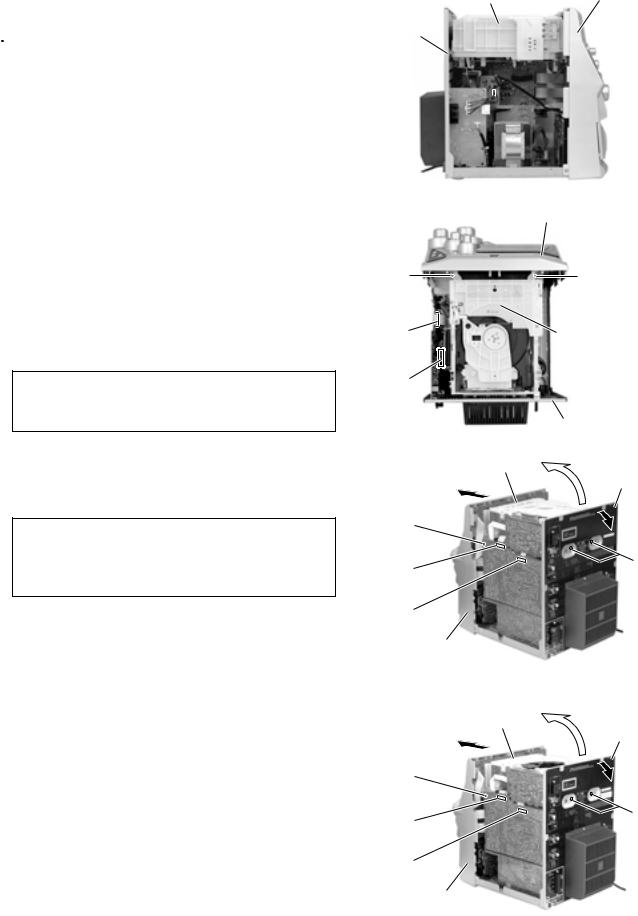
MX-G950V/MX-G880V
MX-G850V/MX-G750V
 Removing the CD changer mechanism assembly (See Fig.4, 6)
Removing the CD changer mechanism assembly (See Fig.4, 6)
Prior to performing the following procedure, remove the metal cover.
1.Disconnect the wire from connector CN705 on the amplifier board.
2.Remove the plastic rivet attaching the main board to the front assembly on the right side of the body.
3.Disconnect the card wire from connector CN661 on the main board.
4.Remove the two screws C on the upper side of the body and the two screws D on the back of the rear panel.
5.Pull both the rear panel and the front panel assembly to the outside, then remove the CD changer mechanism assembly by lifting the rear part of the assembly.
REFERENCE:At this point, one card wire on the underside of the CD mechanism assembly is still connected.
6.Disconnect the card wire from connector CN504 on the inner side of the main board on the right side of the body. Remove the CD mechanism assembly.
CAUTION: To prevent damage to the CD fitting, be sure to pull both the rear panel and the front panel assembly enough to remove the CD changer mechanism assembly.
CD changer mechanism assembly |
Front panel assembly |
Rear panel
Amplifier board
CN705 
|
Fig.4 |
|
|
Front panel assembly |
|
C |
C |
|
Main board |
CD changer |
|
CN661 |
||
mechanism assembly |
||
|
||
CN504 |
|
|
|
Rear panel |
|
|
Fig.5 |
|
CD changer mechanism assembly |
||
|
Rear panel |
|
Plastic rivet |
|
|
Main board |
D |
|
CN661 |
|
|
CN504
Front panel assembly
Fig.6
(CA-MXG850VU, CA-MXG950VUX)
CD changer mechanism assembly
|
Rear panel |
Plastic rivet |
|
Main board |
D |
CN661 |
|
CN504
Front panel assembly
Fig.6
(CA-MXG750VUS)
1-6
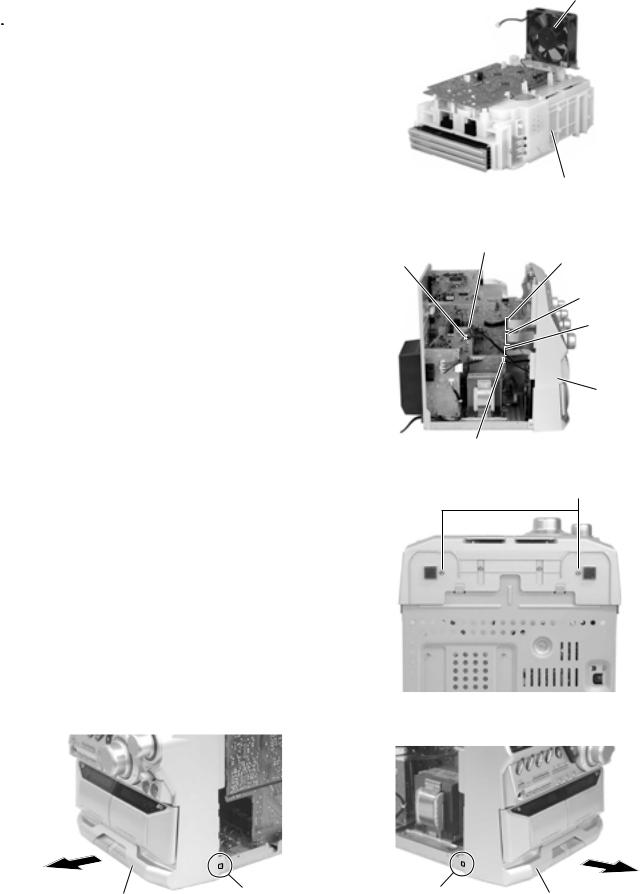
|
Removing the fan |
(See Fig.7) |
|
Prior to performing the following procedure, remove the metal cover and the CD changer mechanism assembly.
1.Turn over the CD changer mechanism assembly and remove the two screws E attaching the fan.
 Removing the front panel assembly
Removing the front panel assembly
(See Fig.8 ~ 11)
Prior to performing the following procedure, remove the metal cover and CD changer mechanism assembly.
1.Disconnect the card wires from connector CN870, CN871 and CN315 on the main board respectively.
2.Remove the band and disconnect the wire from connector CN703 on the amplifier board.
3.Disconnect the wire from connector CN220 on the transformer board.
4.Remove the two screws F on the bottom of the body.
5.Release the two joints a on the lower right and left sides of the body using a screwdriver, and remove the front panel assembly toward the front.
Front panel assembly |
Joint a |
Fig.10
MX-G950V/MX-G880V
MX-G850V/MX-G750V
Fan
E
 E
E
CD changer mechanism assembly
Fig.7
Amplifier board |
Band |
Main board |
CN703 |
|
CN870 |
CN871
CN315
Front panel assembly
Transformer board
CN220 Fig.8
F
(Bottom)
Fig.9
Joint a
Front panel assembly
Fig.11
1-7
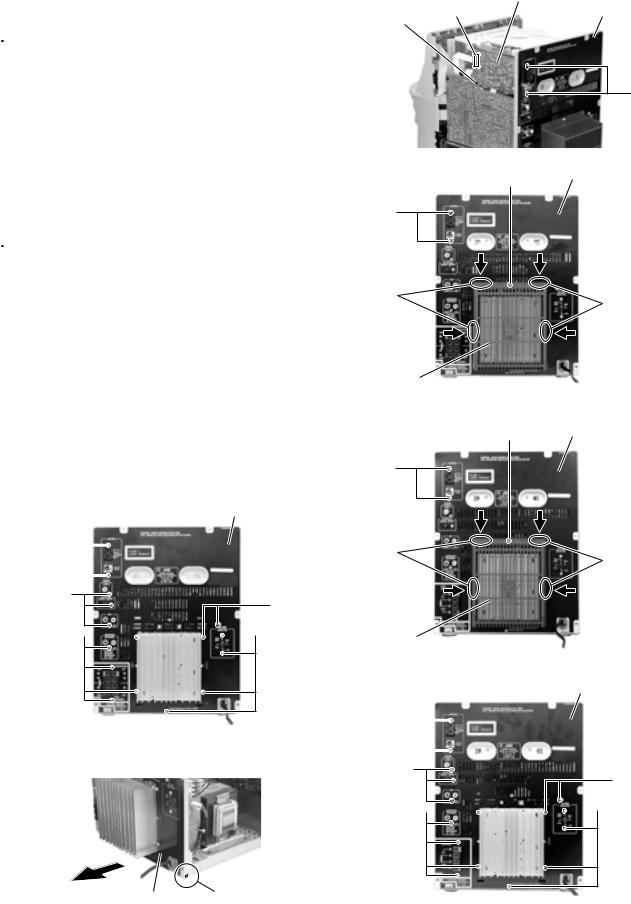
MX-G950V/MX-G880V
MX-G850V/MX-G750V
 Removing the tuner board
Removing the tuner board
(See Fig.12)
Prior to performing the following procedure, remove the metal cover.
1.Disconnect the card wire from connector CN1 on the tuner board on the right side of the body.
2.Remove the plastic rivet fixing the tuner board.
3.Remove the two screws G on the back of the body.
 Removing the rear cover / rear panel (See Fig.13 ~ 16)
Removing the rear cover / rear panel (See Fig.13 ~ 16)
Prior to performing the following procedure, remove the metal cover and the CD changer mechanism assembly.
1.Remove the screw H attaching the rear cover on the back of the body.
2.Push each tab of the four joints b in the direction of the arrow and release.
3.Remove the sixteen screws G attaching the rear panel.
4.Disengage the joints c on each lower side of the rear panel using a screwdriver and remove the rear panel backward.
Rear panel
G
G
G
G
 G
G
Fig.14
(CA-MXG850VU, CA-MXG950VUX)
|
Tuner board |
CN1 |
Rear panel |
Plastic rivet
G
Fig.12
H |
Rear panel |
|
G
Joint b
Joint b
Rear cover
Fig.13
(CA-MXG850VU, CA-MXG950VUX)
H |
Rear panel |
|
G
Joint b
Joint b
Rear cover
Fig.13
(CA-MXG750VUS)
Rear panel
G
G
G
G
 G
G
Rear panel |
Joint c |
|
Fig.14 |
Fig.15 |
(CA-MXG750VUS) |
1-8

MX-G950V/MX-G880V
MX-G850V/MX-G750V
Joint c |
Rear panel |
Joint c |
Rear panel |
|
|
||
|
Fig.16 |
|
Fig.16 |
(CA-MXG850VU, CA-MXG950VUX) |
(CA-MXG750VUS) |
||
 Removing the main board
Removing the main board
(See Fig.17 ~ 19)
Prior to performing the following procedure, remove the metal cover, the CD changer mechanism assembly, the rear panel and the tuner board.
1.Disconnect the card wires from connector CN870, CN871 and CN315 on the main board.
Main board |
Front panel assembly |
|
CN870 |
||
|
||
CN871 |
|
CN315
Amplifier board
CN704
CN706
Fig.17
2.Disconnect the wires from connector CN704 and CN706 on the amplifier board.
3.Remove the screw I attaching the main board on the right side of the body.
4.Disconnect the wire from connector CN710 on the speaker board.
5.Disconnect connector CN211 and CN212 on the main board from the regulator board.
Main board |
Amplifier board |
CN704, CN706 |
Speaker board
CN710
Fig.18
(CA-MXG850VU, CA-MXG950VUX)
Front panel assembly
Main board |
Amplifier board |
CN704, CN706 |
|
|
Main board |
|
|
|
Speaker board |
|
|
|
|
CN710 |
|
|
|
|
CN211 |
|
Regulator board |
I |
|||
CN212 |
||||
|
Fig.19 |
Fig.18 |
||
|
(CA-MXG750VUS) |
|||
1-9

MX-G950V/MX-G880V
MX-G850V/MX-G750V
 Removing the speaker board
Removing the speaker board
(See Fig.20)
Prior to performing the following procedure, remove the metal cover, the CD changer mechanism assembly and the rear panel.
REFERENCE: It is not necessary to remove the main board.
1.Disconnect the wire from connector CN710 on the speaker board.
2.Disconnect connector CN217 on the speaker board from the regulator board.
 Removing the power board (See Fig.21)
Removing the power board (See Fig.21)
Prior to performing the following procedure, remove the metal cover, the CD changermechanism assembly and the rear panel.
1.Remove a band on the power board.
2.Disconnect the wire from connector CN218, CN219 and CN250 on the power board.
3.Disconnect connector CN213 on the power board from the regulator board.
Speaker board
CN701
Regulator board
CN217
Fig.20
(CA-MXG850VU, CA-MXG950VUX)
Speaker board
CN710
Regulator board
CN217
Fig.20
(CA-MXG750VUS)
CN218
Power board
CN219
CN250
CN213
Band
Fig.21
1-10
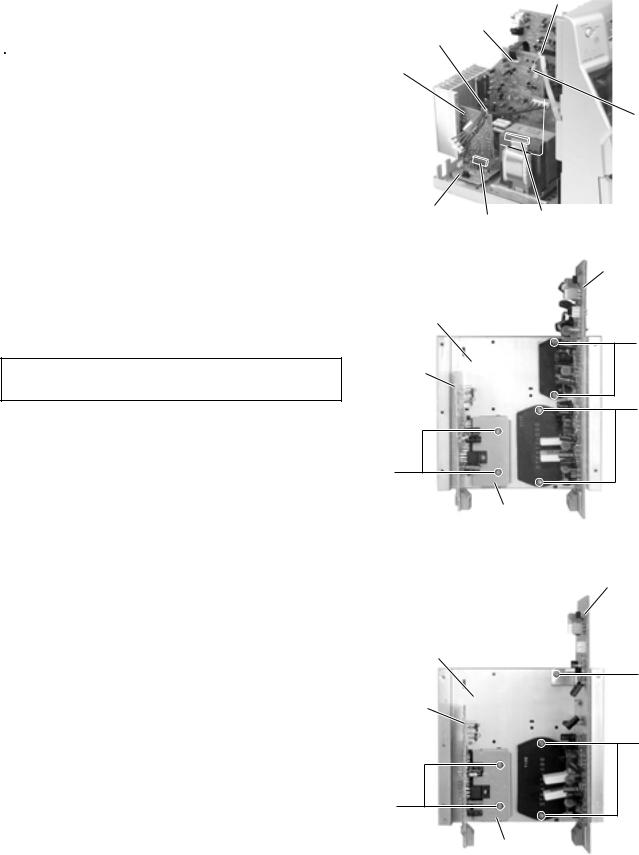
 Removing the amplifier board / voltage board / heat sink (See Fig.22, 23)
Removing the amplifier board / voltage board / heat sink (See Fig.22, 23)
Prior to performing the following procedure, remove the metal cover, the CD changer mechanism assembly and the rear panel.
1.Disconnect the wires from connector CN703, CN704 and CN706 on the amplifier board respectively.
2.Remove the two band attaching the wire to the amplifier board and the voltage board.
3.Disconnect connector CN215 on the amplifier board and CN216 on the voltage board from the regulator board (The heat sink will be detached at once).
4.Remove the four screws J attaching the amplifier board to the heat sink.
5.Remove the two screws K, the board bracket and the voltage board.
REFERENCE: It is not necessary to remove the power board.
MX-G950V/MX-G880V
MX-G850V/MX-G750V
Amplifier board Band
CN704
CN706
Band
Voltage board
CN703
Regulator board
CN216 CN215
Fig.22
Amplifier board
Heat sink
J
Voltage board
J
K
Board bracket
Fig.23
CA-MXG850VU, CA-MXG950VUX)
Amplifier board
Heat sink
J
Voltage board
J
K
Board bracket
Fig.23
(CA-MXG750VUS)
1-11
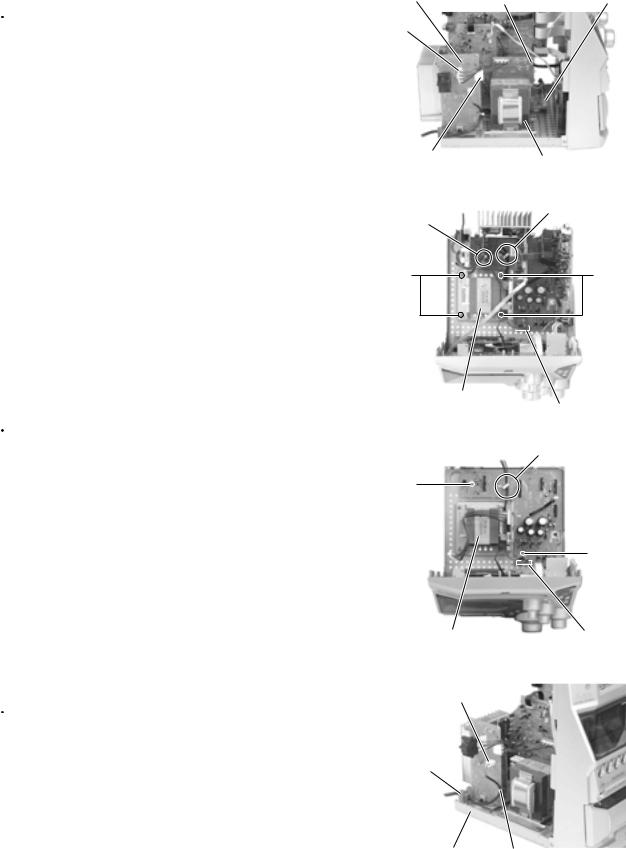
MX-G950V/MX-G880V
MX-G850V/MX-G750V
|
Removing |
the power transformer |
|
||
|
assembly |
(See Fig.24, 25) |
Prior to performing the following procedure, remove the metal cover, the CD changer mechanism assembly and the rear panel.
1.Disconnect the wires from connector CN218 and CN219 on the power board.
2.Disconnect the wire from connector CN204 on the regulator board.
3.Disconnect the wire from connector CN220 on the transformer board.
4.Remove a band on the voltage board.
5.Release the wire from the stopper on the regulator board.
6.Remove the four screws L attaching the transformer assembly.
 Removing the regulator board
Removing the regulator board
(See Fig.26)
Prior to performing the following procedure, remove the metal cover, the CD changer mechanism assembly, the rear panel, the antenna board, the main board, the amplifier board, the voltage board, the power board and the speaker board.
1.Disconnect the wire from connector CN204 on the regulator board.
2.Release the wire from the stopper on the regulator board.
3.Remove the two screws M attaching the reglator board.
 Removing the power cord (See Fig.27)
Removing the power cord (See Fig.27)
Prior to performing the following procedure, remove the metal cover, the CD changer mechanism assembly and the rear panel.
1.Disconnect the wire from connector CN250 on the power board.
2.Remove the band from the power board.
3.Move the power cord stopper upward and pull out it from the base chassis.
Power board |
Transformer board |
Regulator board |
CN220 |
CN204 |
|
CN219 |
|
|
CN218 Power transformer assembly
Fig.24
Stopper
Band
L |
L |
Power transformer |
Regulator board |
assembly |
|
Fig.25 |
CN204 |
|
|
|
Stopper |
M
M
Power transformer assembly |
Regulator board |
Fig.26 |
CN204 |
|
|
Power board |
|
CN250 |
|
Power cord stopper
Base chassis |
Band |
Fig.27
1-12
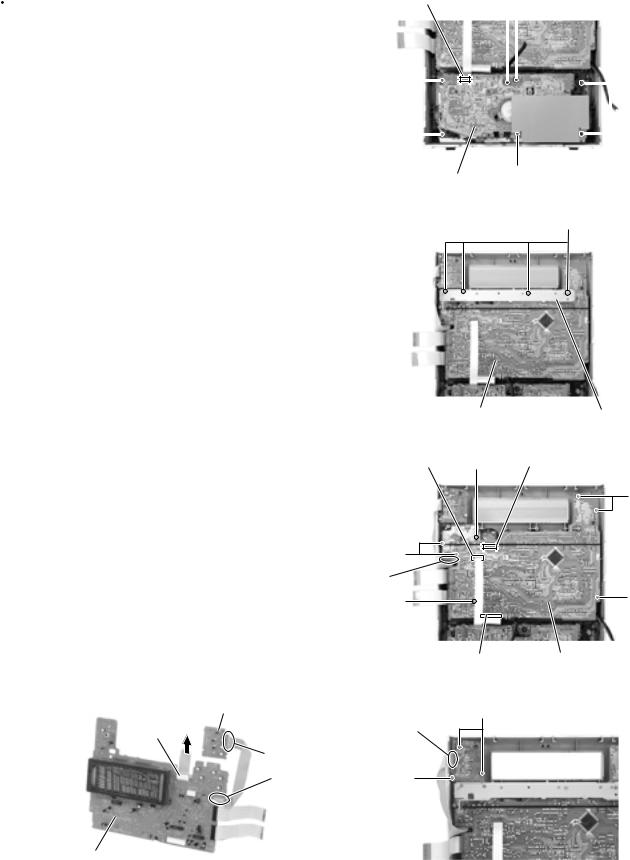
<Front panel assembly>
Prior to performing the following procedure, remove the metal cover, the CD changer mechanism assembly and the front panel assembly.
|
Removing |
the cassette mechanism |
|
||
|
assembly |
(See Fig.28) |
1.Disconnect the card wire from connector CN306 on the head amplifier & mechanism control board.
2.Remove the seven screws N attaching the cassette mechanism assembly.
MX-G950V/MX-G880V
MX-G850V/MX-G750V
Head amplifier |
|
& mechanismcontrol board |
N |
CN306 |
N |
|
|
|
|
|
|
|
|
N |
|
|
|
|
|
|
|
|
||
|
|
|
|
|
|
||||
|
|
|
|
||||||
|
|
|
|
|
|
|
|
|
|
Cassette mechanism |
N |
assembly |
Fig.28 |
|
 Removing the display system control board (See Fig.29 ~ 31)
Removing the display system control board (See Fig.29 ~ 31)
1.Remove the four screws O attaching the stay bracket.
2.Disconnect the card wires from connector CN316 and CN880 on the display system control board.
3.Remove the seven screws P attaching the display system control board.
4.If necessary, disconnect the wire from connector CN911 on the front side of the display system control board and unsolder FW915.
 Removing the CD eject board
Removing the CD eject board
(See Fig.31, 32)
1.Remove the three screws Q attaching the CD eject board.
2.If necessary, unsolder FW915 on the CD eject board.
CD eject board
CN911
FW915
FW915
Display system control board
Fig.31
O
Display system control board |
Stay bracket |
||
|
Fig.29 |
|
|
CN316 |
P |
CN911 |
|
|
|
|
P |
P |
|
|
|
FW915 |
|
|
|
(Solding) |
|
|
P |
P |
|
|
|
|
CN880 |
Display system control board |
|
|
Fig.30 |
|
|
CD eject board |
Q |
|
|
FW915 |
|
|
|
(Solding) |
|
|
|
Q
Fig.32
1-13
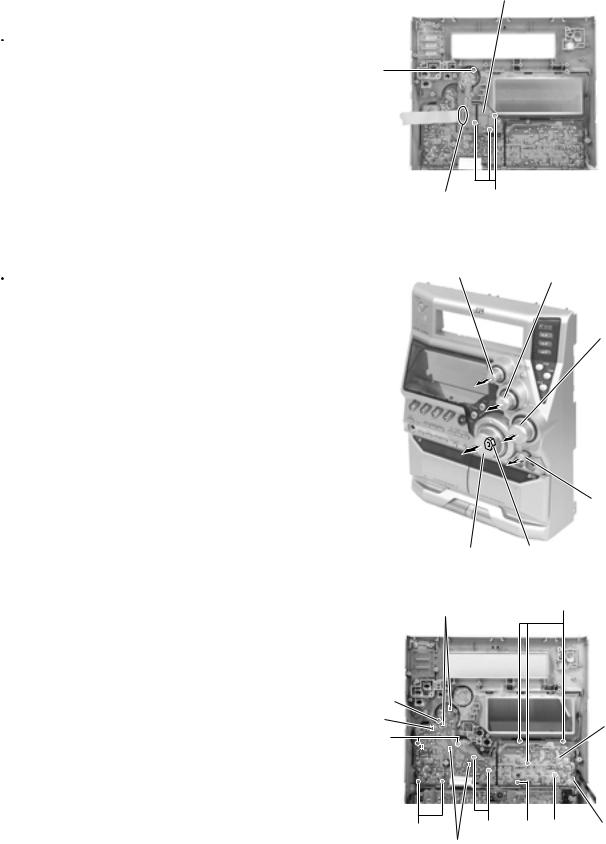
MX-G950V/MX-G880V
MX-G850V/MX-G750V
 Removing the preset / tuning switch board (See Fig.33, 34)
Removing the preset / tuning switch board (See Fig.33, 34)
Preset / tuning switch board
|
Prior to performing the following procedure, remove |
|
the display system control board. |
|
R |
1. |
Pull out the preset knob on the front panel. |
2. |
Remove the four screws R attaching the preset / |
|
tuning switch board. |
3. |
If necessary, unsolder FW901 on the preset / tuning |
|
switch board. |
|
FW901 |
R |
|
(Solding) |
Fig.33 |
|
Removing the operation switch board |
|
|
|
|
|
|
|
|
(See Fig.34, 35) |
|
|
Preset knob |
Sound mode knob |
|
Prior to performing the following procedure, remove |
|
|
|
|
|
the display system control board and the preset / |
|
|
tuning switch board. |
Sub woofer |
|
|
|
1. Pull out the volume knob on the front panel and |
level knob |
|
|
||
|
remove the nut. Pull out the sound mode knob, the |
|
|
mic level knob and the sub woofer level knob toward |
|
|
the front. |
|
2. Remove the twelve screws S attaching the |
|
|
|
operation switch board. |
|
3. Release each tab of the seven joints g retaining the |
|
|
|
operation switch board. |
|
|
|
Mic level knob |
Volume knob Nut
Fig.33
S
Joint g
S
Joint g
S
Joint g 
S S S S
Joint g
Operation switch board
Joint g
Fig.35
1-14
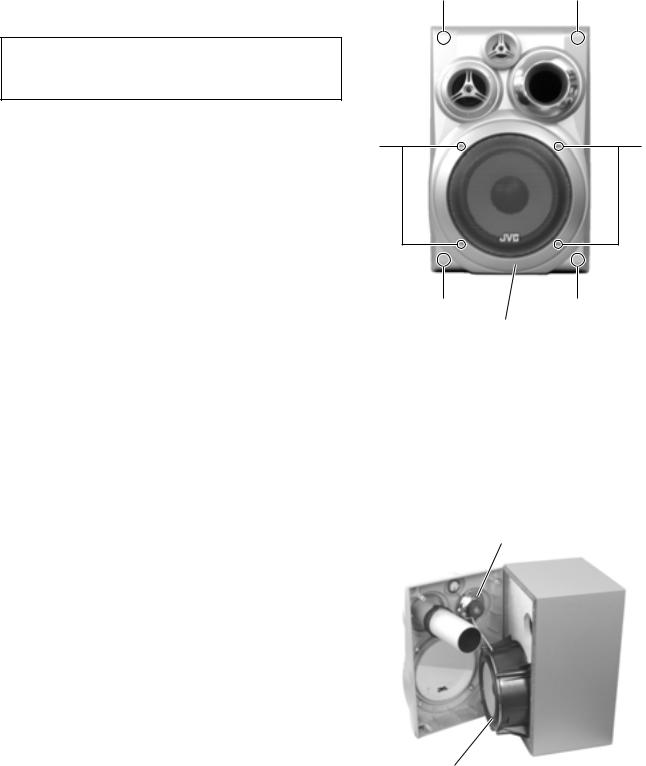
MX-G950V/MX-G880V
MX-G850V/MX-G750V
Disassembly method
<speaker section>
Joint a |
Joint a |
 Removing the front cover (See Fig.1,2)
Removing the front cover (See Fig.1,2)
CAUTION: Do not break or damage the front panel and body that are glued at the joints a.
(See Fig.1)
1. Remove the four screws A on the front of the body |
A |
A |
respectively. |
2.Remove the front cover toward the front and disconnect the yellow and black wires from the two tweeter speaker terminals.
Joint a |
Joint a |
Front cover
Fig.1
(SP-MXG750V) (SP-MXG850V) (SP-MXG950V)
Tweeter speaker
Woofer speaker
Fig.2
(SP-MXG750V) (SP-MXG850V) (SP-MXG950V)
1-15

MX-G950V/MX-G880V
MX-G850V/MX-G750V
 Removing the woofer speaker (See Fig.3)
Removing the woofer speaker (See Fig.3)
Prior to performing the following procedure, remove the front cover.
1.Remove the four screws B on the front of the body.
2.Pull out the woofer speaker toward the front and disconnect the wire (yellow and black,red and black) from the two speaker terminals.
B
B
Woofer speaker
Fig.3
(SP-MXG750V) (SP-MXG850V) (SP-MXG950V)
 Removing the tweeter speaker
Removing the tweeter speaker
(See Fig.4)
Prior to performing the following procedure, remove the front cover.
1.Disconnect the red and black wires from the two tweeter speaker terminals.
C
2.Remove the two screws C attaching the tweeter speaker on the back of the front cover.
Tweeter speaker
Front cover
Fig.4
(SP-MXG750V) (SP-MXG850V) (SP-MXG950V)
1-16
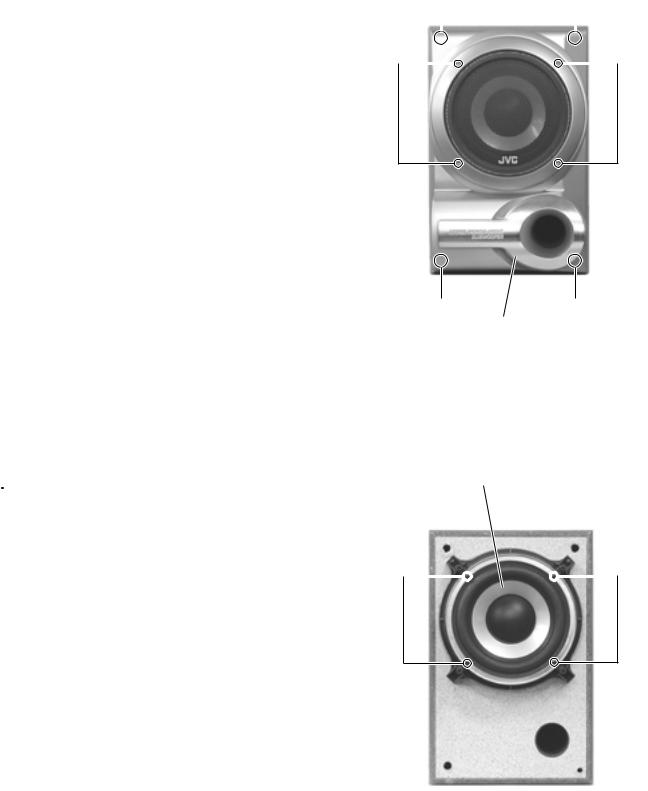
MX-G950V/MX-G880V
MX-G850V/MX-G750V
<Woofer speaker section>
 Removing the front cover (See Fig.5)
Removing the front cover (See Fig.5)
|
|
Joint b |
Joint b |
|||||
|
|
|
|
|
|
|
|
|
CAUTION: Do not break or damage the front panel and |
|
|
|
|
|
|
|
|
|
|
|
|
|
|
|
|
|
body that are glued at the joints b. |
|
|
|
|
|
|
|
|
(See Fig.5) |
D |
|
|
|
|
|
|
D |
|
|
|
|
|
||||
1.Remove the four screws D on the front of the body respectively.
2.Remove the front cover toward the front.
Joint b |
Joint b |
|
Front cover |
 Removing the woofer speaker (See Fig.6)
Removing the woofer speaker (See Fig.6)
Prior to performing the following procedure, remove the front cover.
1.Remove the four screws E on the front of the body.
2.Pull out the woofer speaker toward the front and disconnect the red and black wires from the two speaker terminals.
Fig.5
(SP-MXG850V) (SP-MXG950V)
Woofer speaker
E
 E
E
Fig.6
(SP-MXG850V) (SP-MXG950V)
1-17

MX-G950V/MX-G880V
MX-G850V/MX-G750V
<Removing the Rear speaker>
|
|
|
|
|
Rear cover |
||
|
|
Removing the Rear cover (See Fig.7 ~ 9 ) |
|
|
|
|
|
|
|
|
|
|
|
|
|
|
|
|
|
|
|
|
|
1. |
Remove the four screws F on the back of the body. |
|
|
|
|
|
|
2. |
Disconnect the wires from the two terminals on the |
F |
|
|
|
F |
|
|
|
|
|||||
|
|
rear speaker. |
|
|
|
|
|
3.Remove the four screws G on the back of the front cover.
Fig.7(SP-MXG950V)
Rear cover
Front cover
Rear speaker terminals
Fig.8(SP-MXG950V)
Front cover |
Rear speaker |
|
G |
G |
Rear speaker terminals
Fig.9(SP-MXG950V)
1-18
